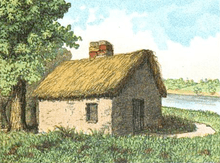William Blaxton

Reverend William Blaxton (also spelled William Blackstone) (1595–1675) was an early British settler in New England, and the first European settler of modern-day Boston and Rhode Island.
Biography
Blaxton was born in Horncastle, Lincolnshire,[1] England and attended Cambridge University, earning a bachelor's degree in 1617 and a master's in 1621. He then became an Anglican priest, although he had several disagreements with the church. This led to his decision to join the failed Gorges expedition to America in 1623.
He arrived in modern-day Weymouth, Massachusetts in 1623 as a chaplain in the Robert Gorges expedition. Most of his fellow travelers returned to England in 1625, and he became the first European to settle in Boston, living alone on what became Boston Common and Beacon Hill.
The Puritans landed in nearby Charlestown in 1629, and in 1630 Blackstone invited them to settle on his land in Boston after they had problems finding potable water. The Puritans then granted Blackstone 50 acres (200,000 m2) of his own land, which he promptly sold back to them.
According to Louise Lind, author of William Blackstone: Sage of the Wilderness (1993):
While the Puritans also disagreed with leaders of the established Church, they proved to be quite intolerant of anyone who disagreed with them. Blackstone soon tired of their intolerance, and moved about 35 miles (56 km) south of Boston, to a hill overlooking a wide bend in what the Indians then called the Patucket (sic) River and what is today known as the Blackstone River.[2]
Blackstone was the first European settler in modern-day Rhode Island in 1635, before Roger Williams founded his colony the next year in modern-day Providence. The area that Blackstone settled was part of the Plymouth Colony until 1691, came under the jurisdiction of Massachusetts Bay Colony until 1741, and finally became part of the Colony of Rhode Island and Providence Plantations.
Blackstone's home and farm were located in what is now Cumberland, Rhode Island on the river which bears his name. Blackstone called his home "Study Hill;" he was said to have the largest library in the colonies at the time. (His library and house were burned during King Philip's War circa 1675.) He tended cattle, planted gardens, and cultivated an apple orchard. He cultivated the first variety of American apples, the Yellow Sweeting. The farm was in the Lonsdale area of Cumberland. The site is now occupied by the Ann & Hope mill.
Roger Williams and Blackstone disagreed on many theological matters, but "both agreed on the right to disagree, and Williams invited Blackstone to regularly preach to his followers in Providence. Blackstone continued preaching in various parts of Rhode Island and is considered to be the pioneer clergyman of the Protestant Episcopal Church in the United States."[2]
"He preached his brand of tolerant Christianity to American Indians under an oak tree that became an inspiration to Christians worldwide."[3] When he preached in Cumberland, he did it under a large oak tree near his home. The tree survived for centuries until the Hurricane of 1938 toppled it.
Blackstone (Blaxton) briefly returned to Boston in 1659 riding on a bull. At the age of 64, he married widow Sarah Fisher Stevenson. William and Sarah had only one child, John. Sarah died at the age of 48, and Blackstone died in 1675 at the age of 80, leaving substantial holdings in real estate.[4]
Legacy
Namesakes
- Blackstone, Massachusetts
- Blackstone River
- Blackstone River Valley National Heritage Corridor
- Blackstone Canal
- Blackstone Street in Boston
- Blackstone Boulevard, Providence
- Blackstone River and Canal Heritage State Park in Uxbridge, Massachusetts
Memorials
- William Blackstone Memorial Park in Cumberland, Rhode Island
- Plaque on Beacon Street in Boston marking the site of his house
- Plaque on Boston Common commemorating the sale of his land
Notable descendants
- Timothy Blackstone, industrialist
In literature and film
William Blackstone and his conflict with the Puritans are mentioned several times in the novel Under the Volcano by Malcolm Lowry, and briefly in the 1984 film version of the novel. The novel's protagonist Geoffrey Firmin states: "Personally I'd like to be buried next to William Blackstone ... The man who went to live among the Indians." (Under the Volcano, chapter 2)
See also
References
- ↑ http://commons.wikimedia.org/wiki/File:Reverend_William_Blaxton_plaque,_Boston,_MA_-_DSC00183.JPG
- 1 2 "Who is William Blackstone?". Retrieved 2008-06-13.
- ↑ Kevin Keenan (July 23, 2000). "Namesake preserves memory of William Blackstone". Worcester Telegram & Gazette. Retrieved 2008-05-12.
- ↑ Find A Grave
Further reading
- Thomas Coffin Amory. William Blackstone, Boston's first inhabitant, 2nd ed. Boston: Rockwell & Churchill, 1877. Google books
- B.F. DeCosta. William Blackstone in his relation to Massachusetts and Rhode Island. NY: Mallory, 1880. Google books
- "New England in the Earliest Days", A. L. Rowse, American Heritage, May 22, 1959
- The story of William Blackstone, with local color, from the Worcester Telegram & Gazette
- Louise Lind. "William Blackstone, Sage of the Wilderness",Blackstone Valley Tourism Council.
External links
- Early Settlers (from bucklinsociety.net)
- Weymouth - The First Hundred Years, Ted Clarke, Weymouth Historical Commission
- Who is William Blackstone? - short, readable biography of a very interesting pioneer